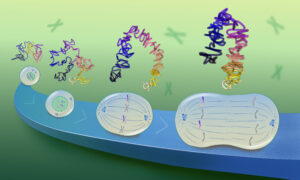Molecular cuisine for gut bacteria
EMBL scientists show how to grow a wide range of gut bacteria in the lab

The bacteria living in the gut have a big impact on our health. But researchers still don’t know what kind of food most of our gut bacteria like to live on, or precisely how they metabolise nutrients. In a Nature Microbiology paper, EMBL scientists report on the growth characteristics of the main human gut bacteria in nineteen different growth media with well-defined recipes. Peer Bork, Kiran Patil and Nassos Typas, all group leaders at EMBL Heidelberg, led the work.
“Our resource provides scientists with tools to experimentally investigate the gut microbiome ecology, going beyond correlations and identifying causes and effects,” says Nassos Typas.
Surprise!
The research team selected 96 strains from 72 bacterial species, representing the most frequently occurring and most abundant species in the human gut plus important species linked to infectious or other types of gut diseases, like colorectal cancer and inflammatory bowel disease (IBD). While characterising their nutritional preferences and ability to produce various molecules, the researchers discovered unknown metabolic features of some bacteria.
“We were surprised to find new bacteria with the capability to utilize mucin, the protein that makes up mucus,” says Kiran Patil. “These bacteria can contribute to inflammation and infection by weakening the protective mucus barrier lining the gut. Another surprise came from bacteria that proved to be inhibited by amino acids and short-chain fatty acids, common ingredients in most growth media. It turns out that rich media with many nutrients can be toxic for these species, whereas we used to think: the more food, the better.”
Furthermore, even closely related bacteria sometimes had completely different nutritional preferences. This shows that microbiologists can’t base their assumptions about metabolic capabilities on bacteria’s genetic relationships alone.
The new scientific ‘cookbook’ is filled with molecular recipes on how to grow gut bacteria, providing the community with the tools for studying the structure and function of the human gut microbiome.
The first authors of the paper are Sergej Andrejev and Melanie Tramontano, who work as a scientific programmer and a postdoctoral fellow in the Patil group at EMBL Heidelberg, respectively.
- Also read ‘Commonly used drugs affect gut bacteria‘, about the related paper ‘Extensive impact of non-antibiotic drugs on human gut bacteria’ that was published in Nature on the same day.
How is gut bacteria grown in the lab?
Typically, scientists have grown gut bacteria by extracting them from faecal samples and combining them with nutrient mixtures that included things like meat extract, yeast extract and tomato juice. Although the bacteria grow well in these mixtures, scientists don’t know the exact nutrients in each mixture, or their quantities and proportions. This makes it hard to study what the bacteria can produce themselves, and to measure their intake and output of different nutrients.
EMBL scientists solved this by developing a recipe for a defined medium for growing gut bacteria. This enables scientists to know exactly which nutrients are available to bacteria and in what quantities.
Finding the right recipe for a medium for gut bacteria was challenging, because:
- Many species of gut bacteria do not grow in the presence of excess amounts of nutrients, Kiran Patil’s lab at EMBL found. So previous approaches of using rich mixtures with many nutrients, in an effort not to miss anything essential, were counter-productive.
- It’s hard to predict what nutrients a particular species of bacteria needs, based on its genome sequence alone. If the bacteria have genes that are similar to the genes from a well-studied species, then scientists can make educated guesses about their nutritional requirements. But for bacteria whose genomes are very different from well-studied species, which is the case for the majority of gut microbes, scientists often have to resort to trial and error, testing many different recipes of growth medium.
- Many gut bacteria are sensitive to oxygen, which is scarce in the gut. This means that bacteria have to be grown in oxygen-free environments.



